Environmental Engineering Reference
In-Depth Information
p
HT1
(at
p
HT2
= 0), MPa
9.34
Dependence of the time of absolutely safe HET operation
(expressed in the number of loading cycles in the heating-cooling
mode) on the pressure in hydraulic testing.
values of the safety margin adopted in international practice under the 'leak
before break' concept.
The results of the analysis of safe operation of tube bundles 2SG1, 2SG3
and 2SG4 are summarised in Fig. 9.35. The probability of the following
events is described here:
• emergence of a leak < 5 l/h (
P
il
);
• emergence of a leak > 5 l/h (
P
g.l.
);
• sudden appearance of a large leak due to tube rupture in the normal
operating conditions (NOC) (
P
f
NOC
);
• sudden appearance of a large leak in the emergency mode characterised
by steam line fracture (
P
f
SLF
).
Probabilities of events
P
g.l.
, P
f
NOC
and
P
f
SLF
(variants No. 10-12, 14-16
and 18) are estimated approximately because of the lack of statistical data
on crack length. In the estimates of the events
P
g.l.
and
P
f
SLF
the detectability
of leakage control was assumed to be 0.9 (due to possible clogging of
cracks with corrosion products). The reliability of inspection of thermal-
hydraulic cycles was also 0.9 (due to the lack of an instrumental system
for controlling and taking into account the thermal-hydraulic modes (such
as SAKOR) [5].
Event
P
f
SLF
in the variant number 20 was assessed as impossible under
the condition that there is no more than nine heating-cooling cycles between
two hydraulic tests (
p
HT1
= 24.5 MPa and
p
HT2
= 0).
Thus, the aggregate results of the calculations described above suggest
that the life and safe operation of tube bundles in SG1, SG3 and SG4 of
unit 2 of the Balakovo NPP are ensured under the following conditions:
• Conducting HT with pressure
p
HT1
= 24.5 MPa,
p
HT2
= 0 and then
plugging all leaky pipes;
• reactor shutdown when a leak of 5 l/h from the primary to secondary
circuit is detected and leaky pipes are plugged;

Search WWH ::

Custom Search